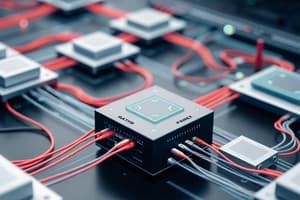Podcast
Questions and Answers
A technician is troubleshooting a computer that cannot connect to the network. They suspect a faulty cable. Which tool would be MOST appropriate to test the cable's connectivity?
A technician is troubleshooting a computer that cannot connect to the network. They suspect a faulty cable. Which tool would be MOST appropriate to test the cable's connectivity?
- Crimping tool
- Lens cleaner
- LAN tester (correct)
- Soldering iron
When installing a new network card, what should a technician verify to prevent conflicts?
When installing a new network card, what should a technician verify to prevent conflicts?
- The card's resource settings (correct)
- The color of the network cable
- The type of screws used to secure the card
- The ambient temperature of the room
A computer can't connect to the network. The technician suspects a firewall issue. What should they do to test this?
A computer can't connect to the network. The technician suspects a firewall issue. What should they do to test this?
- Reinstall the operating system.
- Temporarily disable the firewall. (correct)
- Check the computer's event logs for errors.
- Replace the network card.
You are making a UTP cable. After arranging the wires in the correct order, what is the next step?
You are making a UTP cable. After arranging the wires in the correct order, what is the next step?
If a user reports an electrical accident, what is the FIRST action to take?
If a user reports an electrical accident, what is the FIRST action to take?
Why is it important to have an accident reporting policy?
Why is it important to have an accident reporting policy?
What is thermal paste primarily used for in a computer system?
What is thermal paste primarily used for in a computer system?
You need to connect two computers directly using UTP cables. Which type of cable should you use?
You need to connect two computers directly using UTP cables. Which type of cable should you use?
What does a solid green LED on a network card typically indicate?
What does a solid green LED on a network card typically indicate?
During accident investigations, who typically analyzes the accident report to determine the cause?
During accident investigations, who typically analyzes the accident report to determine the cause?
Flashcards
Tools for Testing Computer Systems
Tools for Testing Computer Systems
Tools that help users identify errors in computer hardware and networks.
Screwdrivers
Screwdrivers
Used for installing and removing screws.
Pliers and tweezers
Pliers and tweezers
Used for picking up small components.
LAN Tester
LAN Tester
Signup and view all the flashcards
Crimping tool
Crimping tool
Signup and view all the flashcards
Soldering iron
Soldering iron
Signup and view all the flashcards
Computer Networks
Computer Networks
Signup and view all the flashcards
Crossover Cable
Crossover Cable
Signup and view all the flashcards
Straight-Through Cable
Straight-Through Cable
Signup and view all the flashcards
Accident Reporting Policy
Accident Reporting Policy
Signup and view all the flashcards
Study Notes
Tools for Testing Computer Systems
- Tools and equipment are important for troubleshooting, helping users identify errors in computer hardware and networks.
Tools for Testing Hardware Problems
- Screwdrivers install and remove screws.
- Pliers and tweezers pick up small parts.
- Soldering irons connect terminals in power supplies and circuit boards using soldering lead.
- Anti-static wrist straps, mats, and sprays eliminate electrostatic discharge.
- Lens cleaners clean optical media like DVD-ROMs and CD writers.
- Thermal paste dissipates heat from the processor.
Network Troubleshooting Tools
- LAN testers test network connections.
- Crimping tools crimp RJ45 connectors to UTP cables.
Causes of Network Trouble
- Networks may fail if a network card isn't properly connected, drivers/software settings are faulty.
- A network may fail due to firewall restrictions, connection problems, or bad network hardware.
Network Trouble Solutions
- Due to varied network configurations, the following recommendations may not apply to all systems.
- If issues persist after troubleshooting, contact the network administrator or company representative.
- Verify network cable connections at the back of the computer and check the LEDs for proper illumination.
- A solid green LED indicates the card is either connected or receiving a signal.
- Ensure a new network card's resources are properly set without conflicting with other hardware.
- Verify the network card's ability to detect itself using the ping command in Windows/MS-DOS prompts.
- Unix/Linux variant OS users perform ping via the shell.
- Verify the correct protocols are installed.
- Most networks use TCP/IP, but may also use IPX/SPX and NetBEUI.
- The user must specify an IP address and subnet mask when the TCP/IP protocol is installed, if a DNS server or other computer does not assign the IPX address.
- Ensure all necessary ports are open if your network uses a firewall; if possible, disable the firewall software or disconnect the computer to rule out firewall issues.
- It can take a computer 2-3 minutes to connect or detect the network after booting.
- If problems persist after following recommendations, with TCP/IP, ping another computer's IP address to check if the computer can send/receive data.
Computer System and Network Configurations
- Computer networks connect computers, software, and hardware, enabling users to collaborate.
- Cabling systems, specialized software, and devices manage data traffic on a network.
- Users can share files and resources like printers, and send messages electronically.
- Designing a network plan can take 1-3 working days, based on network size and assistance available.
Making Cabling
- Remove 12mm of the outermost vinyl shield from one end of the cable (A-side).
- Arrange metal wires in parallel according to the wire arrangement table without removing the shield of each metal line.
- Insert the metal wires into the RJ45 connector, keeping the metal wire arrangement.
- Use pliers to set and squeeze the RJ45 connector with the cable tightly.
- Repeat these steps on the other end of the cable (B-side).
- The cable can be set at either end of the device.
10 Base T / 100 Base T Straight-through
- 10BaseT and 100BaseT are common LAN modes using UTP category-5 cable.
- A UTP category-3 cable can be used for 10BaseT, which contains 3 wires.
- The pin configuration is:
- Pin 1: white-orange to white-orange
- Pin 2: orange to orange
- Pin 3: white-green to white-green
- Pin 4: blue to blue
- Pin 5: white-blue to white-blue
- Pin 6: green to green
- Pin 7: white-brown to white-brown
- Pin 8: brown to brown
- A straight cable connects a computer to a hub or two hubs through an uplink port.
10 Base T / 100 Base T Crossover
- Cross cables for 10BaseT and 100BaseT connect two computer directly using only a UTP cable.
- It is also used for connecting 2 hubs with a normal port on both hubs, a relatively rare configuration.
- The pin configuration is:
- Pin 1: white-orange to white-green
- Pin 2: orange to green
- Pin 3: white-green to white-orange
- Pin 4: blue to blue
- Pin 5: white-blue to white-blue
- Pin 6: green to orange
- Pin 7: white-brown to white-brown
- Pin 8: brown to brown
Inspecting and Testing Configured Computer Systems and Networks
- Practice good housekeeping during and after machine maintenance.
- Place removed parts in safe locations away from personnel during servicing.
Electrical Safety
- Electric current from power, telephone, and communication cables can be a hazard.
- Disconnect power cords, telecommunications systems, networks, and modems before removing server/workstation covers unless specifically instructed otherwise.
- Disconnect power before performing mechanical inspections, working near power supplies, or removing/installing the main unit.
- To avoid risk of electrocution, unplug the machine's power cord before beginning work.
- Never assume a circuit is de-energized; always verify that the power has been switched off first.
- Be vigilant for possible hazards, such as moist floors, non-grounded power extension cables, and power surges.
- In the event of an electrical accident, turn off the power and send for medical assistance.
Accident Reporting Policy and Procedure
- Implement a process for reporting accidents and incidents for quick action and tracking causes.
- The organization should define what, to whom, and how to report, and document the process.
- These are the defined rules and guidelines to ensure proper documentation, reporting, and investigation of all accidents and injuries.
- Designed to promote safety, prevent future incidents, and comply with legal, organizational mandates.
- The aim is to ensure that all accidents, injuries, and near-miss incidents are correctly reported and investigated.
- All employees, students, or visitors involved in/witnessing an accident must report it.
- Report workplace injuries, accidents involving equipment, fires, electrical incidents, or chemical spills.
- Report accidents to a teacher, supervisor, or safety officer immediately.
- All accident reports are kept confidential to protect the privacy of those involved.
Accident Investigation Procedures
- Prioritize safety and call for medical help if someone is hurt.
- Remove immediate hazards to prevent further accidents.
- Report the Accident Immediately to the teacher, supervisor, or safety officer.
- Document injured person's name, date/time, injury type, first aid, and actions taken to avoid future accidents.
- Submit the report to the appropriate person/department, such as the school administrator or principal.
- A safety officer or administrator analyzes the report to find the accident's cause through interviews, equipment checks, and policy reviews.
- Execute corrective actions based on the investigation, by repairing faulty equipment, enhance safety measures, and provide extra training.
- Supervisors/teachers should follow up with the injured person to check they are recovering well and safety inspections should also be conducted to prevent further accidents.
Studying That Suits You
Use AI to generate personalized quizzes and flashcards to suit your learning preferences.





